Félix Roussel/ Arosa Sun
A model of the Félix Roussel is shown below, in het final livery as Arosa Sun. On her funnel, you can clearly spot the 'Hoogovens' logo, the five blocks forming a starfish.
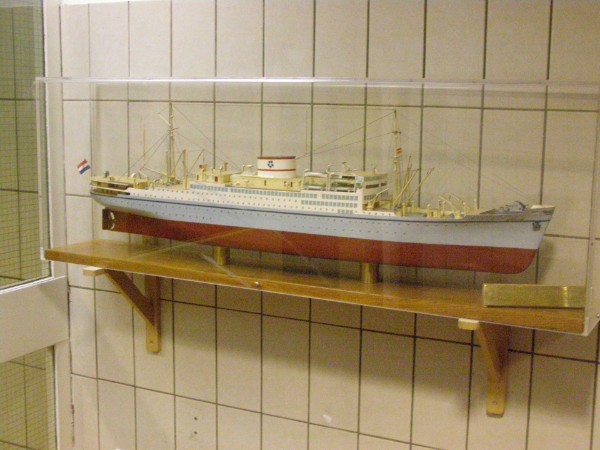
Just a ten minute walk from my front door is the largest steelplant in Western Europe, Tata Steel IJmuiden. Formerly this was named Hoogovens, untill it was absorbed in the British company Corus, that itself was later absorbed into the Indian steelgiant Tata. On the large grounds of the company is also a small museum, named the Hoogovens Museum. Within this museum, several artefacts of a French liner built for Messageries Maritimes in 1931 are on display.
That seems a little odd, of course. But this ship, the Félix Roussel, was a housing vessel for Hoogovens between 1960 and 1974, when the ship was sold for scrap in Spain. Before scrapping, Hoogovens preserved several items from the ship, then named Arosa Sun, and those are now on display in the new museum since 2008.
The ships bell is also preserved at the Hoogovens museum, of course still with the name Félix Roussel. Normally, a ships bell will keep its original inscription, even after a namechange. Also the year of her inauguration (1931) and her orininal homeport (Marseille) are inscripted.

Félix Roussel is one out of a class of three that were built in the early 1930's for the Messageries Maritimes route between France and Indochina. Messageries Maritimes was the second largest French shipping company, after of course the CGT, the French Line. The sisters of Félix Roussel were not that fortunate. One of them, the George Philippar, survived her first outbound voyage to China, but during her first return voyage the ship caught fire at may 16th 1932 and sank a few days later near Aden. Fifty-four passengers died in this incident. The other sister, named Aramis, was seized by the Japanese in 1942 at Saigon becoming their transporter Teia Maru. She was sunk by an American submarine in August 1944 near the Philippines.
Félix Roussel had a tonnage measurement of 17.539 when built and a lenght of 567 feet. She was a twin-screw ship with a sevice speed of around 15 knots. Speed here was less important then on the competitive North Atlantic. In four classes, some 1045 passengers could be sailing her, 196 in first class, 110 in second, 89 in thirth and 650 in steerage. The ship was built in France, at the Ateliers et Chantiers de la Loire, that was based in Saint Nazaire. Like most Messageries Maritimes liners, the ships of this class were kinda odd to see. They sported two very flat, square funnels very much unlike the model shown on top of the page. Het interiour decor was very rich, though. The ship was themed for the Eastern countries she visited, that can still be seen within the few artefacts pictured on this page. Her interiours being a blend between European and Indo-China styling. The main restaurant was looking like the inside of an Oriental Angkor temple under a blue ceiling, representing the tropical skies. Living palmtrees brightened up the smokingroom, done in French style. Also, several cabins had balconies (yes! in 1929) and also a swimmingpool and tenniscourt were part of the entertainment facilities. The ship was named after a company chairman, who had passed away in 1925. Félix Roussel was launched at the 17th of december 1929 from the Ateliers et Chantiers de la Loire at Saint-Nazaire. At the 26th of february 1931, the Félix Roussel departed for her maiden voyage to the Far East.
Below, one out of three steeringwheels is on display. These wheels stood in a trio on the upper decks of the ship.
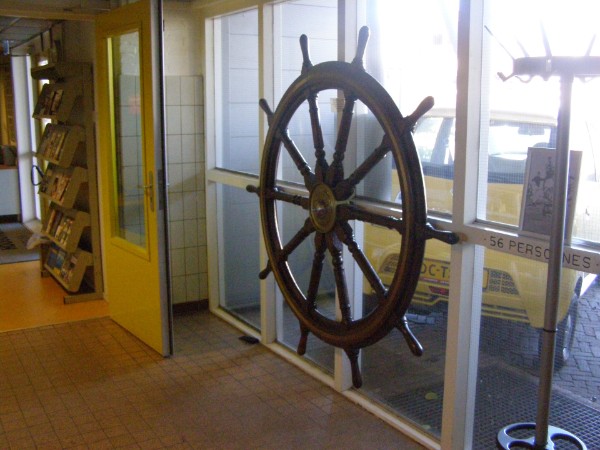
The ship normally sailed from Marseille in southern France via Suez to French Indochina and the Far East. Those ships on this route could be operated because of heavy subsidies from the French government, not uncommon in those days. The service lasted untill the second world war broke out and she was requisitioned as a British troopship. When she was delivered back to her French owners in 1948, the ship was rebuilt and she emerged as shown in the model on top of the page, with one streamlined funnel midships.
Also part of the swichboard is shown in the hallway of the museum. The name of the constructor is also shown. Of course, every single one points to 'zero', but it is great to see it still exsists today.
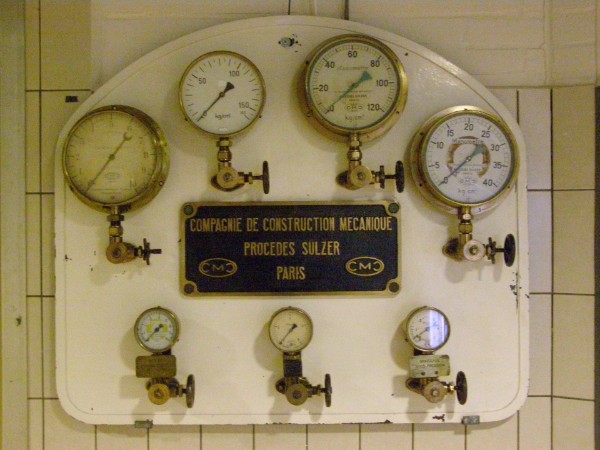
On april 25th, 1955, the ship was sold to a Swiss firm named Arosa Lines and renamed Arosa Sun. The colonial trades from France declined sharply and Arosa was able to keep the ship sailing in the North Atlantic trade from Bremerhaven to New York and Canadian ports. Arosa was filling the gap that followed after the second world war in passengershipping from Germany. It was impossible for the traditional German firms to operate transatlantic passengerliners due to restrictions and the Swiss firm was of course able to fill in. The crew of the ship came from the North German Lloyd, one of the companies that normally had sailed the same service before the war. She now sailed under the flag of Panama but not for long. Before the end of the decade, in 1959, the ships sailings stopped, as there were claims against her for at least 2,3 million US dollars.
The IJmuiden steel plants of Hoogovens grew fast after the second worldwar as steel was in great demand. The company expanded quickly and used a lot of workers from outside The Netherlands, mainly from Italy and Spain. Because of this great number of foreigners, housing in the small community of Velsen was a problem and to partially solve this, Hoogovens bought the now workless Arosa Sun and had her rebuilt as an accomodation vessel for the Italian and Spanish workers. The ship docked in IJmuiden very cose to the plant in 1960 and stayed a familiar sight on this spot untill 1974, when she was finally sold for scrap in Spain. She had one misfortune in those days, when she caught fitre in april 1963, although there were no severe injuries.
In Velsen, still a lot of Spanish and Italian former Hoogovens employees have a nostalgic and colourfull bond with the ship and also Hoogovens was very pleased with the ship as a solution for the problems. This is also why the company did keep a few artefacts from the ship as a living memory to the history of Hoogovens. The items were stored out of the publics eyes untill 2008, when the newly created Hoogovens Museum recieved the items to be displayed. As a main piece, the ships bell is present but a lot of other artefacts show a little of the ships grandeur.
The tiger shown below was once part of the ships stairwell. Because the voyages of the Félix Roussel took her from Marseille to Indochina, her overall decor was also themed evenly. Even with the small amount of artefacts preserved by Hoogovens, you can get a small sence of what her style was like.
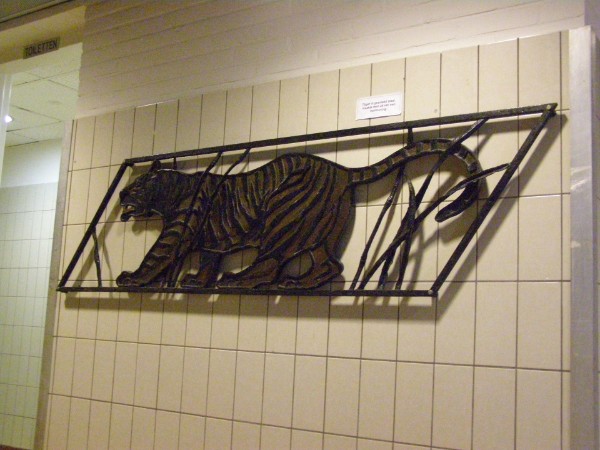
There are also several woodcarvings and cast-iron panels on display. This duo is seen in the Arosa Sun Hall, a part of the museum that is used for converences. A small question at the museums counter was enough to visit the hall. The people of the museum were very helpfull to tell about every artefact from the ship and to swich on the lights in the Arosa Sun Hall for good photography.
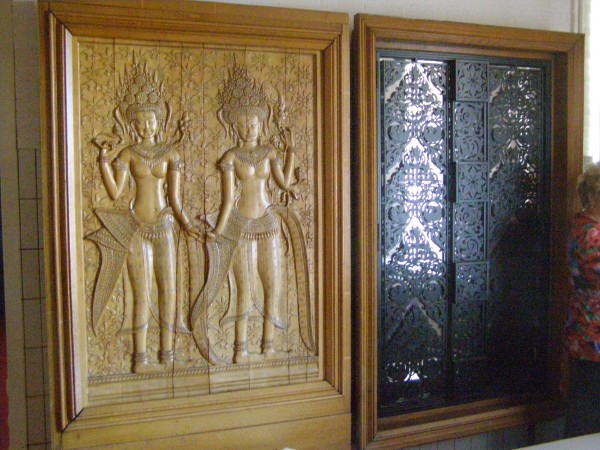
Several more cast-iron panels are on display in the hallway between the entrance of the museum and the bathrooms. Within these panels, tropical plants and animals like monkeys can be recognized.
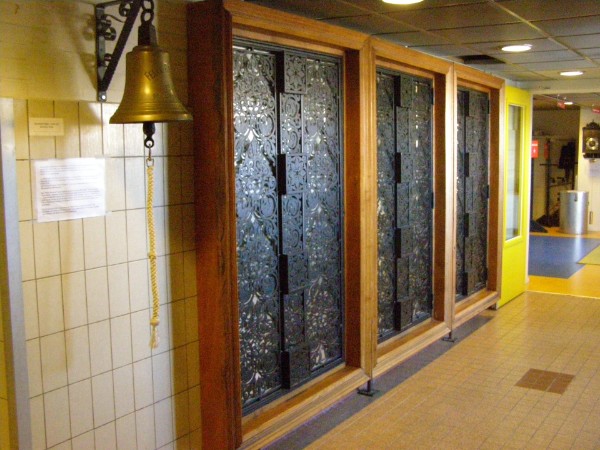
I am very pleased that I learned about the museum and the oceanliner treasures that it has on display. Also the rest of the museum is very interesting, the community of Velsen is largely built around the steelplant next to the fish-industries and of course the locks and northsea canal. When you are in Holland and you are interested in ocean liner memorabilia, the Hoogovens Museum is a must-see.
 | |  |
This eastern statue is just one survivor of two equal statues. Those were placed on either side of the main stairwell of the ship. Nowadays, the statue is placed in a corner of the Arosa Sun Hall, but when the ship sailed, these were very distinctive features onboard. | | Above, an up-close image of one of the ships cast-iron panels can be seen. It surprised me that the museum has this many panels of the ship. Although of course the amount of artefacts is limited, it is great to know that just a ten minute walk from my front door, these are still here for everyone to see. |
For more information about the museum, visit www.hoogovensmuseum.nl although the site is in Dutch only.

